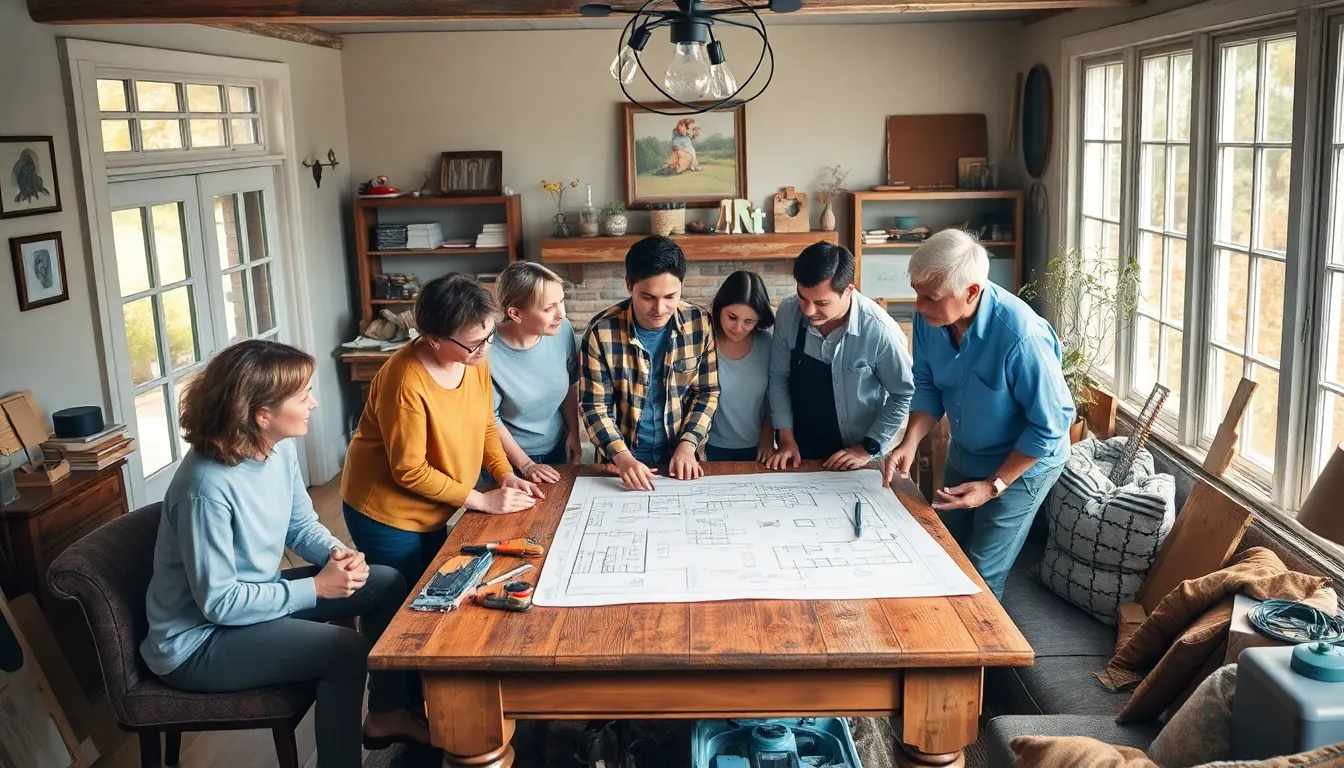Old homes have a charm that’s hard to resist. They whisper stories of the past and offer a unique canvas for creativity. But let’s face it—sometimes that charm comes with a side of questionable plumbing and wallpaper that hasn’t seen the light of day since disco was in style. Renovating an old home can feel like unearthing a treasure chest filled with surprises, and not all of them are good.
Old Home Renovation
Old home renovation embraces the charm and character of historical architecture while addressing modern living needs. It involves a careful balance between maintaining original features and incorporating contemporary elements.
Importance of Preserving History
Preserving history provides numerous benefits. Historical homes connect communities to their past, strengthening cultural identity. Renovations can enhance property values, as unique architectural styles attract buyers. Sustainable materials often replace damaged elements, reducing landfill waste and honoring the environment. Each renovation nurtures craftsmanship, showcasing skilled artisans who restore period details. Maintaining structural integrity ensures long-lasting safety, allowing occupants to enjoy the home’s legacy.
Common Challenges Faced
Old home renovations present specific challenges. Outdated electrical systems may require upgrades to meet safety standards. Plumbing issues frequently arise, with aging pipes leading to leaks and inefficiencies. Asbestos and lead paint often lurk in older homes, necessitating careful removal by professionals. Structural concerns may develop, particularly in roofs and foundations that have deteriorated over time. Designing spaces that accommodate modern lifestyles while respecting historical aesthetics can prove complicated. Homeowners should anticipate unexpected repairs and budgeting flexibility during the renovation process.
Planning Your Renovation

Planning an old home renovation requires careful thought and organization. Homeowners must consider practicality alongside aesthetics.
Setting a Realistic Budget
Creating a budget requires understanding both anticipated and unexpected costs. Homeowners should account for structural repairs, modern upgrades, and permits. Including a contingency of 10% to 20% is wise for surprise expenses. Costs vary widely; for example, kitchen remodels may range from $20,000 to $50,000, depending on scope. Analyzing quotes from multiple contractors provides a clearer financial picture. Setting priorities helps focus spending on high-impact areas, like electrical systems or foundational work.
Seeking Professional Help
Hiring professionals can simplify the renovation process significantly. Contractors and designers often possess specialized skills, enhancing project success. Referrals from friends or online reviews can lead to qualified experts. Obtaining multiple bids helps compare service and price, ensuring informed choices. Home inspectors assess structural integrity, uncovering hidden issues. Engaging with local historical societies may yield resources for compliance with preservation standards. Developing clear communication with professionals establishes project expectations and minimizes misunderstandings.
Key Areas to Focus On
Renovating an old home involves several critical areas that demand attention. Homeowners must prioritize these aspects to ensure a successful project.
Foundation and Structural Repairs
Foundation integrity stands at the forefront of any renovation project. Identifying cracks or settling issues requires immediate action, as these problems can escalate quickly. Structural repairs involve reinforcing beams and addressing sagging floors. Inspecting the basement for moisture or mold issues is essential, as these factors can compromise safety and structural soundness. Maintaining the original architecture while strengthening the foundation contributes significantly to the home’s longevity. Homeowners often save on long-term costs by addressing structural concerns early in the renovation process.
Electrical and Plumbing Updates
Electrical systems need thorough evaluation in older homes. Outdated wiring poses safety risks and may not meet modern standards. Seeking professional assistance ensures safe upgrades while enhancing functionality. Replacing old plumbing fixtures reduces leak risks and improves water efficiency. Inspecting pipes for corrosion or damage helps avoid costly repairs later on. Prioritizing electrical and plumbing updates can increase a home’s value and comfort. Adequate planning in these areas often prevents future inconveniences and complications.
Design Considerations
Design considerations play a crucial role in successfully renovating an old home. Balancing modern functionality with historical charm enhances both aesthetics and value.
Blending Modern and Traditional Styles
Blending modern and traditional styles creates a unique living environment. Consider incorporating modern fixtures and appliances alongside vintage architectural features. Maintaining original elements, like moldings or hardwood floors, adds character. Mixing contemporary colors with classic patterns fosters an inviting atmosphere. Use furniture that complements both styles, ensuring harmony throughout the space. This approach allows homeowners to enjoy modern conveniences without compromising historical integrity.
Choosing the Right Materials
Choosing the right materials significantly impacts the outcome of a renovation. Opt for sustainable options, aligning with preservation goals while enhancing durability. Local sourcing ensures access to materials that complement the home’s character. Reclaimed wood offers authenticity and warmth, making it an excellent choice for various applications. High-quality finishes elevate the overall design and functionality of spaces. Careful material selection can improve a home’s aesthetic appeal while respecting its historical significance.
Conclusion
Old home renovations offer a unique opportunity to blend history with modern living. By navigating the challenges and embracing the charm of these properties, homeowners can create spaces that tell a story while meeting contemporary needs. Prioritizing structural integrity and thoughtful design ensures that renovations not only enhance comfort but also preserve the essence of the past.
With careful planning and a focus on sustainability, each project can breathe new life into historical homes, making them valuable assets for generations to come. The journey may be complex but the rewards of restoring an old home are truly worth the effort.

